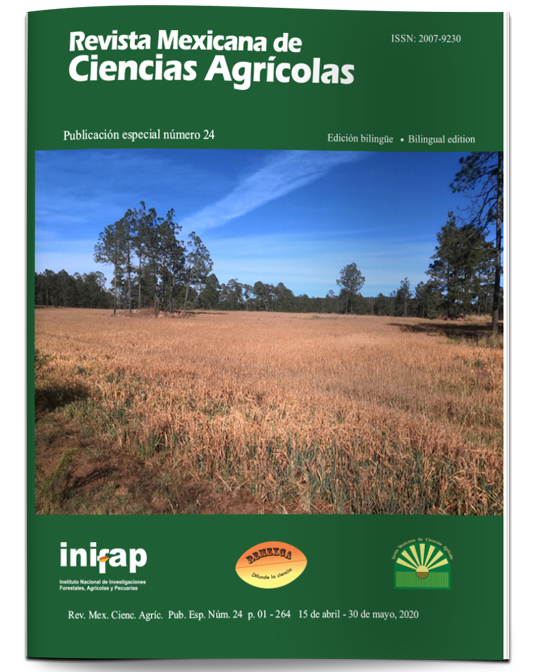Yield of five varieties of lucerne during four years of evaluation
DOI:
https://doi.org/10.29312/remexca.v0i24.2365Keywords:
biomass production, forage accumulation, lucerne, seasonal yieldAbstract
The aim of this study was characterize the forage production of five lucerne varieties in Montecillos, Texcoco, state of Mexico. Grassland with varieties Cuf-101, Moapa, Oaxaca and Valenciana were established in 2004, in which the annual dry matter yield (ADMY), seasonal yield (SY), forage accumulation rate (FAR) and leaf: stem ratio. The data were analyzed by the GLM procedure of SAS and comparison of means by the Tukey test. Changes by season, variety and years and their interactions were analyzed. Differences (p< 0.05) in ADMY, MSE, FAR and leaf: stem relationship were found between varieties, seasons and years. During the first year, higher ADMY was observed, and decreased to 57% at the end of the evaluation period. The Oaxaca variety maintained the highest production at the end of the evaluation and Moapa the lowest. In the SY it was observed that in summer it had the highest performance and in winter it decreased about 50%, a trend that was maintained during the evaluation period, this difference decreases over the years, with a more constant accumulation of DM in year. The leaf: stem ratio is higher in the second year where the Cuf-101 and Valenciana varieties registered the highest relationship in the winter season. In conclusion, the genotype of the lucerne variety influences the dry matter yield by season, year and production period, where the season of greatest DM production is summer.
Downloads
Downloads
Published
How to Cite
Issue
Section
License
The authors who publish in Revista Mexicana de Ciencias Agrícolas accept the following conditions:
In accordance with copyright laws, Revista Mexicana de Ciencias Agrícolas recognizes and respects the authors’ moral right and ownership of property rights which will be transferred to the journal for dissemination in open access. Invariably, all the authors have to sign a letter of transfer of property rights and of originality of the article to Instituto Nacional de Investigaciones Forestales, Agrícolas y Pecuarias (INIFAP) [National Institute of Forestry, Agricultural and Livestock Research]. The author(s) must pay a fee for the reception of articles before proceeding to editorial review.
All the texts published by Revista Mexicana de Ciencias Agrícolas —with no exception— are distributed under a Creative Commons License Attribution-NonCommercial 4.0 International (CC BY-NC 4.0), which allows third parties to use the publication as long as the work’s authorship and its first publication in this journal are mentioned.
The author(s) can enter into independent and additional contractual agreements for the nonexclusive distribution of the version of the article published in Revista Mexicana de Ciencias Agrícolas (for example include it into an institutional repository or publish it in a book) as long as it is clearly and explicitly indicated that the work was published for the first time in Revista Mexicana de Ciencias Agrícolas.
For all the above, the authors shall send the Letter-transfer of Property Rights for the first publication duly filled in and signed by the author(s). This form must be sent as a PDF file to: revista_atm@yahoo.com.mx; cienciasagricola@inifap.gob.mx; remexca2017@gmail.
This work is licensed under a Creative Commons Attribution-Noncommercial 4.0 International license.



